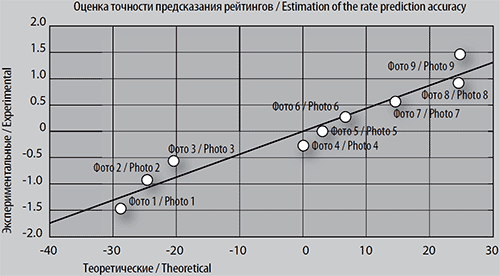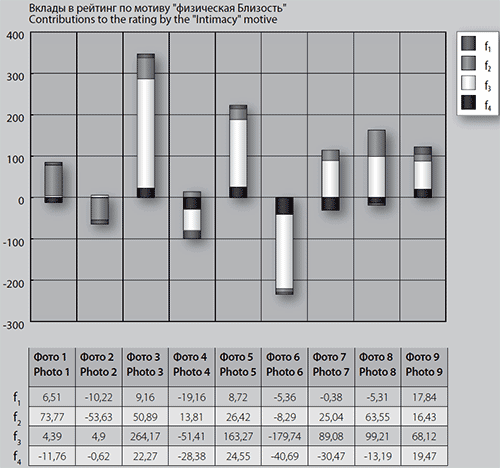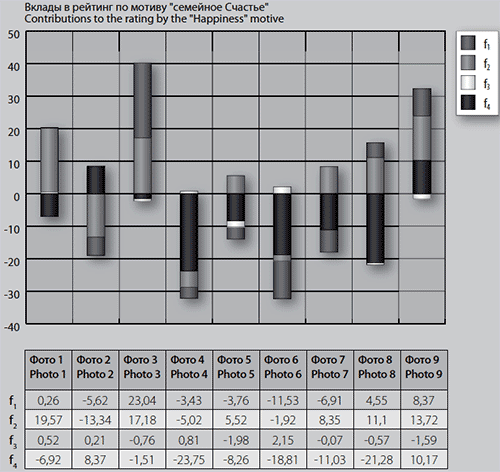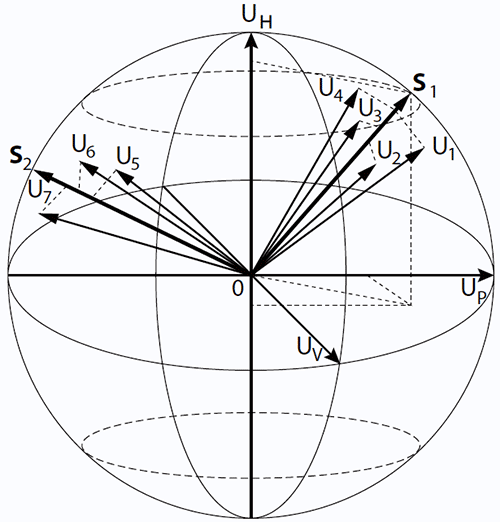Article
Petrenko V.F., Suprun A.P., Yanova N.G. (2017). Psychosemantic study of female visual perception of men (Russian mentality). National Psychological Journal, 4, 67–74.
Abstract
Background. The evaluation of the visual object by the perceiving subject depends both on the features of the object (qualities, characteristics, properties), on the one hand, and the characteristics of the subject of perception (mentality, inherent archetypes, gender, aesthetic representations, value systems, motivation, etc.). Therefore, speaking about external beauty, we must first build a typology of subjects of evaluation, and then conduct an analysis of preferences within homogeneous groups.
Objective. Isolation of signs and semantic interpretations of visual preferences is a complex task. We limit its decision to a search, pilotage study of a supposedly more or less homogeneous sample of male students from one of the Siberian universities, Russia.
Design. The study involved 30 males aged 20-23 years. The subjects were presented with 9 photographs, which they had to rank according to 8 descriptors discussed in focus groups previously. The ranking of photo portraits was carried out with respect to two motives: the desire to have physical intimacy and the possibility to be happy with woman in the photo.
Conclusion. Four main independent factors of female’s estimation of men were revealed, which explained 89 per cent of the total variance. Motivational vector is identified as a certain direction in the semantic space that defines the most optimal ratio of factors required to meet the existing needs. Projections of each coordinate of the vector object of all axes of the semantic space allow to determine the contribution of each factor to the motivational significance of the objects. The psychosemantic approach can be realized when solving a wide range of research in the study of human preferences (advertising, fashion, image of socially significant persons, objects of perception of art, etc.), and also to analyze the motivation of the person on whom the system of his preferences is based. Vector descriptions used in psychosemantics provides the psychologist with the opportunity to apply the mathematical methods and analogues of the natural sciences methods to analyze the mentality of a person and his/her individual picture of the world.
Accepted: 10/14/2017
Pages: 67-74
DOI: 10.11621/npj.2017.0406
PDF: Download
Keywords: interpersonal perception; visual image; attractiveness; motivation; semantic space; factor analysis;
Available Online 01.01.2018
Table 1. Factor loading of the main evaluation criteria for women
|
Properties |
Factors |
|||
|
F1 |
F2 |
F3 |
F4 |
|
|
The object of male pride and prestige (physical attractiveness, femininity, athletic appearance) |
0,69 |
0,19 |
0,33 |
-0,48 |
|
Potential wife |
0.92 |
0.09 |
-0.07 |
-0.13 |
|
Sexual, potential love-maker |
0.03 |
0.19 |
0.78 |
-0.55 |
|
A faithful friend, a reliable colleague |
0.05 |
0.11 |
0.95 |
0.11 |
|
Careful guardian (will help in trouble, illness and misfortune) |
0.56 |
0.44 |
-0.12 |
0.52 |
|
Social and family leader |
0.62 |
0.71 |
0.05 |
0.08 |
|
Obedient, compassionate, ready to help |
-0.19 |
0.04 |
0.01 |
0.95 |
|
An interesting interlocutor, a communicative leader in a team |
0.03 |
0.92 |
0.23 |
-0.03 |
|
The overall variance attributable to the factor |
2.06 |
1.65 |
1.70 |
1.74 |
Table 2. Motivational vector of physical intimacy
|
Category |
Semantic coordinates of motivational vector M1 |
|
f1 |
0,09 |
|
f2 |
0,27 |
|
f3 |
0,94 |
|
f4 |
-0,19 |
Table 3. Motivational vector of family relations
|
Category |
Semantic coordinates of motivational vector M2 |
|
f1 |
0,59 |
|
f2 |
0,53 |
|
f3 |
0,07 |
|
f4 |
-0,57 |

Fig. 1. Estimation of the prediction accuracyof the motivation of family relations rate
Table 4. Individual contributions of factors to the "Intimacy" motive (R-rating)
|
Subject of research |
f1 |
f2 |
f3 |
f4 |
R |
|
Photo 1 |
6,51 |
73,77 |
-4,39 |
-11,76 |
132,41 |
|
Photo 2 |
-10,22 |
-53,63 |
-4,90 |
-0,62 |
2,15 |
|
Photo 3 |
9,16 |
50,89 |
-264,17 |
22,27 |
-421,59 |
|
Photo 4 |
-19,16 |
13,81 |
51,41 |
-28,38 |
-18,02 |
|
Photo 5 |
8,72 |
26,42 |
-163,27 |
24,55 |
24,01 |
|
Photo 6 |
-5,36 |
-8,29 |
179,74 |
-40,69 |
-5,31 |
|
Photo 7 |
-0,38 |
25,04 |
-89,08 |
-30,47 |
-6,65 |
|
Photo 8 |
-5,31 |
63,55 |
-99,21 |
-13,19 |
7,54 |
|
Photo 9 |
17,84 |
16,43 |
-68,12 |
19,47 |
5,13 |
Table 5. Individual contributions of factors to the «Happiness» motive (R-rating)
|
Subject of research |
f1 |
f2 |
f3 |
f4 |
R |
|
Photo 1 |
0,26 |
19,57 |
-0,52 |
-6,92 |
21,17 |
|
Photo 2 |
-5,62 |
-13,34 |
-0,21 |
8,37 |
0,63 |
|
Photo 3 |
23,04 |
17,18 |
0,76 |
-1,51 |
56,97 |
|
Photo 4 |
-3,43 |
-5,02 |
-0,81 |
-23,75 |
-60,28 |
|
Photo 5 |
-3,76 |
5,52 |
1,98 |
-8,26 |
26,01 |
|
Photo 6 |
-11,53 |
-1,92 |
-2,15 |
-18,81 |
-3,18 |
|
Photo 7 |
-6,91 |
8,35 |
0,07 |
-11,03 |
-26,79 |
|
Photo 8 |
4,55 |
11,10 |
0,57 |
-21,28 |
21,25 |
|
Photo 9 |
8,37 |
13,72 |
1,59 |
10,17 |
18,61 |

Fig. 2. Factor contributions to the object rating by the «Intimacy» motive

Fig. 3. Factor contributions to the object rating by the « Happiness « motive

Fig. 4. Defining the states (S) of the object according to the evaluation (U)
References:
Atkinson, J.W. (1964) An Introduction to Motivation. N.Y.
Arkes, H.R., &Garske, Y.P. (1982) Psychological Theories of Motivation. Monterey.
Auckett, R., Ritchie, J. & Mill, K. (1988) Gender differences in friendship patterns. Sex Roles, 19, 57–66. doi: 10.1007/BF00292464
Barabanschikov, V.A. (2006) Psychology of perception: the organization and development of the perceptual process. Moscow, KogitoTsentr.
Basow, S. (1992) Gender stereotypes and roles. CA, Brooks/Cole Publ. Comp.
Berelson, В.,&Steiner, G. (1964) Human behavior. N.-Y., Harcourt Brace Jovanovich.
Bern, Sh. (2001) Gender psychology. St. Petersburg,Moscow.
Brenner, O.C., Tomkiewicz, E.C., &Schein, V E. (1989) The relationship between sex role stereotypes and requisite management characteristics revisited. Acad. Of Management J., 32(3), 662–669. doi: 10.2307/256439
Harlow, H.F., & Harlow M. (1966) Learning to love. Am. Sci. 55, 3.
Heider, F. (1960) The gestalt theory of motivation. Jones M.R. (ed.). Nebraska symposium on motivation, 8, Lincoln, University of Nebraska Press.
Ilyin, E.P. (2002) Differential psychophysiology of men and women. St. Petersburg, Piter
Ilyin, E.P. (2002) Motivation and motives. St. Petersburg, Piter.
Kelley, H.H. (1971) Attribution in social interaction. N.Y.
Kobozeva, I.M. (2000) Linguistic semantics. Moscow, Editorial URSS.
Korotchenko, E.A., &Suprun A.P. (2015) Metaphor in Visual Art. Investigations of Cultural Life: Quantitative Aspects. Proceeding of the International Symposium dedicated to the memory of Colin Martindale and 100-th anniversary of Russian formalist school. Ekatininburg, 126–145.
McClelland D.C. (1971) Assessing Human Motivation. N.Y.
Pavlov, I.P. Full composition of writings. Vol. III. Book. 2. Moscow; Leningrad, AN SSSR, 1951–1952.
Petrenko, V.F. (2010) Fundamentals of psychosemantics. Moscow, Eksmo.
Petrenko, V.F., Korotchenko, E.A., & Suprun, A.P. (2010) Still-life as a visual aphorism. [Psihologiya. Zhurnal Vysshey Shkoly ekonomiki], 7(2), 26–44.
Petrenko, V.F., &Suprun, A.P. (2012) Purposeful systems, evolution and subjective aspect of systemology. [Trudy Instituta sistemnogo analiza RAN], 62(1), 3–25.
Petrenko, V.F. (2013) Multidimensional consciousness. Moscow, Eksmo.
Petrenko, V.F., & Suprun, A.P. (2015) Psychosemantic approach to the problem of motivation: Development of personality. [Prometey], 3, 158–177.
Petrenko, V.F., Korotchenko, E.A., & Suprun, A.P. (2011) Research on language of perception still-life as a visual aphorism. Psychology in Russia. State of the Art.Lomonosov Moscow State University, Russian Psychological Society. Moscow, 4, 467–4924.
Petrenko, V.F., & Suprun, A.P. (2012) The Mental Representation of the World in Psychosemantics. The Fifth International Conference on Cognitive Science, 1, Kaliningrad, 137–138.
Semenov, V.E. (1973) Images of marriage and love in youth magazines (experience of content analysis). [Molodezh’, obrazovanie, vospitanie, trudovayadeyatel’nost’]. Leningrad, 85–93.
Suprun, A.P. (2016) Methods of assessments and self-assessments of personality on continuous scales. Development of personality. Moscow, Prometey, 1, 200–208.
Suprun, A.P., Yanova, N.G., & Nosov, K.N. (2013) Metapsychology. Relativistic psychology. Quantum psychology. Psychology of creativity. Moscow, URSS.
Uznadze, D.N. (1969) Psychological motivations of human behavior. Moscow.
Werner, В. (1972) Theories of Motivation. Chicago.
Young, P.T. (1961) Motivation and Emotion. N.Y.
For citing this article:
Petrenko V.F., Suprun A.P., Yanova N.G. (2017). Psychosemantic study of female visual perception of men (Russian mentality). National Psychological Journal, 4, 67–74.


